Native shrubs create beautiful, low-maintenance boundary landscaping while supporting local wildlife. Consider Eastern Redbud for stunning spring blooms, American Elderberry for bird attraction, Ninebark for year-round interest, Buttonbush for wet areas, Aromatic Sumac for fragrant foliage, Black Chokeberry for edible berries, Red Twig Dogwood for winter color, Virginia Sweetspire for fall displays, and Native Viburnums for dense privacy. These indigenous options thrive with minimal care and maximize ecological benefits for your landscape borders.
Eastern Redbud: A Stunning Boundary Showpiece
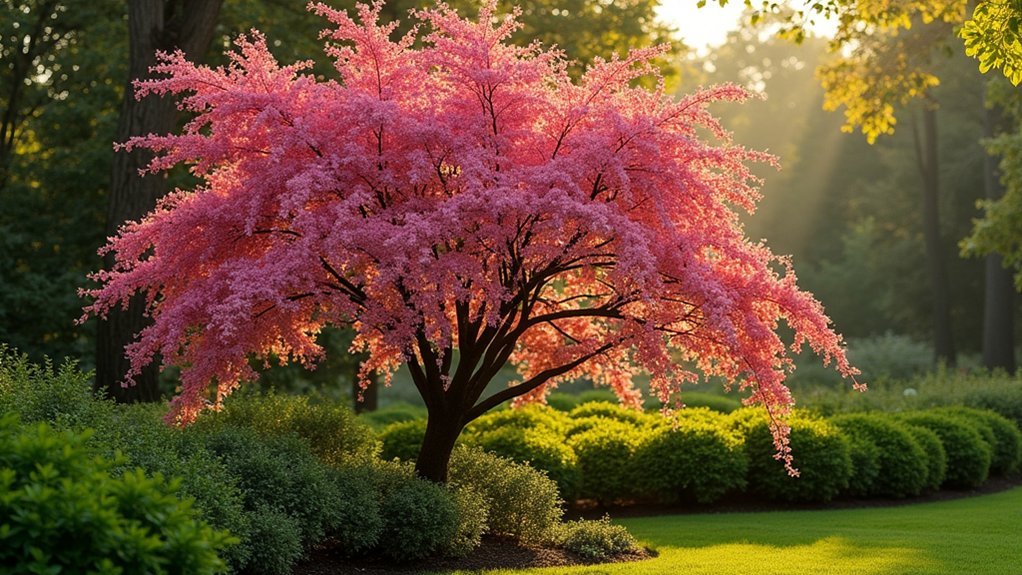
When looking for a stunning native shrub to define your garden boundaries, the Eastern Redbud (Cercis canadensis) stands out as a premier choice. This flowering shrub bursts with pink to purple blooms in early spring, creating a spectacular display before many other plants awaken.
You’ll appreciate how this native species reaches 20 to 30 feet in height—tall enough to establish clear boundaries without overwhelming smaller landscapes. The Eastern Redbud adapts well to various soil conditions and thrives in both full sun and partial shade, making it versatile for different garden locations.
Beyond its beauty, you’ll enjoy the heart-shaped leaves that transform to vibrant yellow in fall. As a bonus, this native shrub supports local pollinators, enhancing biodiversity while serving as your beautiful boundary marker.
American Elderberry for Wildlife-Friendly Borders
Three compelling features make American Elderberry (Sambucus canadensis) an exceptional choice for wildlife-friendly garden borders. This versatile native plant produces clusters of white spring flowers that attract diverse pollinators, instantly enhancing your garden’s biodiversity.
You’ll appreciate its adaptability to various soil conditions, from wet to dry, and its ability to thrive in partial to full sun. Growing up to 12 feet tall and 10 feet wide, it creates a natural privacy screen without chemical treatments.
When you plant American Elderberry, you’re establishing a sustainable ecosystem that supports local wildlife. The berries, edible for humans when cooked, provide essential nutrition for birds.
With minimal maintenance requirements once established, this shrub delivers maximum ecological benefits while beautifully defining your landscape boundaries.
Ninebark Varieties for Year-Round Border Interest

Ninebark varieties offer your garden magnificent seasonal transformations, with foliage shifting from vibrant greens to rich burgundies and golds throughout the year.
You’ll appreciate the distinctive peeling bark that creates visual interest in winter when other plants have lost their appeal.
For smaller spaces, compact cultivars like ‘Little Devil’ and ‘Tiny Wine’ provide all the charm of their larger cousins while fitting perfectly into more confined border settings.
Seasonal Color Changes
Throughout the changing seasons, few native shrubs deliver as dramatic a transformation as the versatile Physocarpus opulifolius varieties.
You’ll witness remarkable seasonal color changes as your Ninebark shifts from fresh green foliage in spring to rich burgundy or golden hues by fall. The ‘Diabolo’ variety especially shines with its deep purple leaves that create striking contrast against delicate white flower clusters.
What makes these native shrubs particularly valuable is their winter appeal. When other plants retreat to dormancy, Ninebark’s exfoliating bark adds textural interest to your landscape.
This year-round visual performance requires minimal maintenance, allowing you to enjoy the evolving display without constant intervention. By incorporating these adaptable shrubs into your border plantings, you’ll create a dynamic boundary that celebrates each season’s unique character while supporting local wildlife.
Distinctive Bark Textures
The showstopping feature of these remarkable native shrubs emerges most prominently during winter months when their exfoliating bark takes center stage. Ninebark (Physocarpus opulifolius) offers visual interest along the edge of your property when other plants have lost their appeal.
Standing 5-10 feet tall, ninebarks create natural boundaries while supporting local wildlife. You’ll find striking varieties like ‘Diablo’ with its deep burgundy leaves and ‘Summer Wine’ featuring dark foliage and pink blooms.
Their adaptability to various soil conditions makes these new plants low-maintenance additions to your landscape. While their peeling bark provides winter drama, you’ll also enjoy late spring flowers and vibrant fall color.
Consider planting ninebarks as sustainable alternatives to traditional hedging plants, delivering year-round textural interest with minimal care requirements.
Compact Cultivar Options
When designing borders with year-round appeal, you’ll want to contemplate compact ninebark varieties that pack visual interest into smaller spaces.
Cultivars like ‘Little Devil’ and ‘Summer Wine’ deliver stunning foliage and seasonal blooms while maintaining a manageable 3-4 foot height profile—perfect for smaller gardens or mixed borders.
You’ll appreciate ninebark’s distinctive peeling bark, which adds fascinating texture during winter months when other plants look dormant.
These versatile shrubs thrive in diverse soil conditions with minimal maintenance, making them excellent choices for sustainable landscapes.
Beyond their aesthetic value, these compact varieties support local ecosystems by providing habitat and food sources for wildlife.
Buttonbush: Perfect for Wet Boundary Areas

If you’re struggling with soggy boundary areas, buttonbush offers an elegant solution with its glossy foliage and distinctive spherical flower clusters that attract bees, butterflies, and other essential pollinators.
You’ll appreciate how this versatile native shrub grows 6-12 feet tall, creating natural screening while stabilizing soil in flood-prone spaces.
Buttonbush requires minimal maintenance once established, making it your ideal four-season boundary choice that thrives precisely where many other landscape plants fail.
Wildlife-Attracting Water Lover
Creating natural boundaries in wet areas presents unique challenges, but buttonbush (Cephalanthus occidentalis) offers an elegant solution while attracting abundant wildlife. This versatile native shrub adapts to both soggy and occasionally dry conditions, making it perfect for dynamic landscape boundaries.
You’ll appreciate buttonbush’s many features:
- Distinctive spherical white flowers that serve as pollinator magnets for bees and butterflies
- Impressive height of 6-12 feet, providing natural screening along waterways
- Glossy foliage that maintains visual interest even when not flowering
- Ability to thrive in wetland conditions while enhancing local biodiversity
When you’re designing natural boundaries near ponds, streams, or marshy areas, buttonbush delivers both practical function and aesthetic appeal while supporting your local ecosystem throughout the seasons.
Four-Season Boundary Solution
While many shrubs disappear into the background after flowering, buttonbush delivers year-round visual interest for wet boundary areas.
You’ll appreciate its adaptability to saturated soils near ponds and streams, making it an ideal natural boundary choice where other plants struggle.
This versatile native grows 3-12 feet tall, creating an effective privacy screen while supporting local ecology.
Its glossy green foliage transforms to brilliant yellow in autumn, while distinctive spherical flower clusters appear from mid-summer through early fall, attracting bees and butterflies.
What you’ll love most is buttonbush’s low-maintenance nature.
Once established, it requires minimal attention while seamlessly blending with native habitats.
If you’re seeking a boundary solution that combines practicality with ecological benefits, buttonbush offers the perfect balance for wet landscapes.
Aromatic Sumac as a Low-Maintenance Border Solution
Homeowners seeking an effortless yet attractive property boundary need search no more than Aromatic sumac. This versatile native shrub adapts to various soil conditions while creating a dense, defining barrier that reaches 3-10 feet tall and spreads equally wide.
You’ll appreciate these standout qualities:
- Stunning seasonal display with fragrant foliage that transforms to brilliant red-orange hues in fall
- Drought-tolerant nature requiring minimal attention once established
- Small yellow flowers that attract beneficial pollinators to your garden
- Wildlife-friendly habitat that enhances your property’s biodiversity
Rhus aromatica offers the perfect combination of practical boundary definition and ecological benefits. Its ability to thrive with little intervention makes it an ideal choice for sustainable landscapes where you want beauty without the maintenance burden.
Virginia Sweetspire for Seasonal Color Transitions
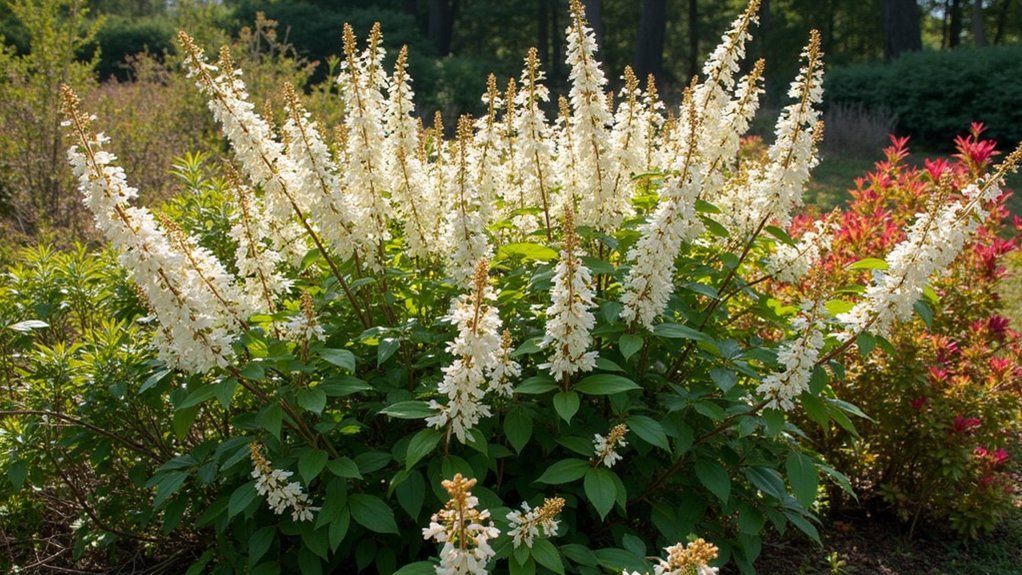
When your landscape begs for year-round visual interest, Virginia Sweetspire (Itea virginica) delivers remarkable seasonal transformations that keep gardens vibrant across changing seasons. This versatile native shrub greets spring with fragrant white blooms that attract essential pollinators to your garden.
You’ll appreciate how this adaptable plant thrives in various soil conditions—even wet areas where other shrubs struggle—making it perfect for rain gardens and challenging spots. Growing 3-5 feet tall and spreading up to 6 feet, it creates an impressive natural boundary while providing wildlife habitat.
Come fall, you’ll be rewarded with a spectacular color show as foliage shifts from green to brilliant reds, oranges, and yellows.
Best of all, once established, Virginia Sweetspire’s disease resistance and low maintenance needs make it an effortless addition to sustainable landscapes.
Black Chokeberry: Edible Landscaping for Property Lines
Black Chokeberry offers a perfect marriage of function and flavor for boundary plantings that work harder than standard privacy screens.
This native Aronia melanocarpa thrives in diverse soil conditions—even wet areas where other shrubs struggle—while reaching a manageable 3-6 feet in height.
You’ll appreciate these multi-season benefits:
- White spring flowers evolve into dark, edible berries perfect for jams and juices
- Spectacular fall foliage provides vibrant color when other plants fade
- Low-maintenance nature means less time pruning and more time enjoying
- Wildlife-friendly characteristics attract birds and pollinators, enhancing your property’s biodiversity
Once established, these resilient shrubs require minimal attention while defining your property line with a productive, beautiful boundary that connects your landscape to local ecosystems.
Red Twig Dogwood for Winter Border Definition
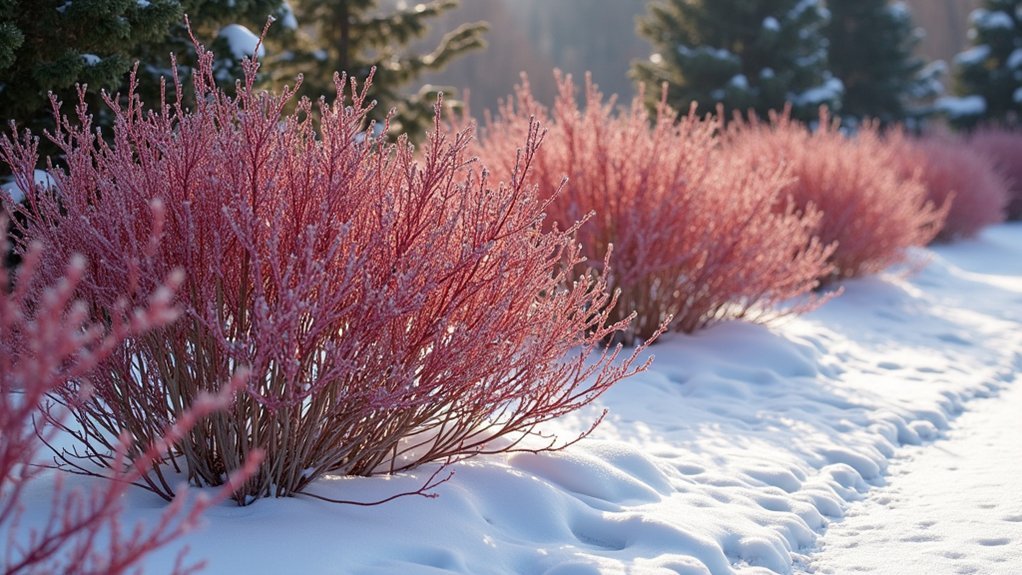
Three seasons of the year simply can’t compare to what Red Twig Dogwood (Cornus sericea) delivers when winter arrives.
When snow blankets your landscape, these native shrubs transform into stunning focal points with their vibrant red stems creating dramatic contrast and visual depth.
You’ll appreciate how this versatile shrub thrives in various soil types, particularly excelling in wet areas where other plants struggle.
Once established, you’ll enjoy its low-maintenance nature, making it an ideal choice for sustainable landscape boundaries.
Effortless beauty for your property’s edge—Red Twig Dogwood creates natural boundaries that care for themselves.
Beyond aesthetics, Red Twig Dogwood serves as valuable wildlife habitat, providing food and shelter for birds throughout the year.
If you’re looking to define property lines with native plantings that offer year-round benefits and spectacular winter interest, this adaptable shrub deserves a prime spot in your garden design.
Mountain Laurel for Shade-Tolerant Boundary Plantings
Shade-challenged boundary areas finally meet their match with Mountain Laurel (Kalmia latifolia), a native flowering shrub that reaches impressive heights of up to 10 feet.
You’ll appreciate how this versatile plant thrives in areas where other boundary options struggle, while supporting your local ecosystem.
When you choose Mountain Laurel for your landscape, you’ll enjoy:
- Stunning clusters of pink or white blooms in late spring
- Adaptability to various soil types, especially acidic conditions
- Minimal maintenance requirements once established
- Dense growth habit that effectively creates privacy and defines property lines
This shade-tolerant native serves multiple purposes in your garden—providing seasonal beauty, supporting pollinators and birds, and creating natural boundaries that blend seamlessly into woodland settings.
Native Viburnum Species for Dense Privacy Screens
While Mountain Laurel excels in shadier boundary areas, native Viburnum species offer exceptional privacy solutions across various light conditions. Arrowwood Viburnum (V. dentatum) creates particularly effective screens with its compact growth habit and dense foliage.
You’ll appreciate these shrubs’ adaptability to local soils and climates, requiring minimal maintenance compared to non-native alternatives. Plant them in groups to establish a lush natural boundary that supports pollinators and wildlife.
| Species | Height | Special Features | Light Needs |
|---|---|---|---|
| V. dentatum | 6-10′ | Blue berries, fall color | Sun to part shade |
| V. prunifolium | 12-15′ | Edible fruit, drought-tolerant | Full sun to shade |
| V. nudum | 5-12′ | Pink-to-blue berries | Part shade |
| V. trilobum | 8-12′ | Edible red berries | Full sun to part shade |
Frequently Asked Questions
What Is the Best Border Shrub?
The best border shrub depends on your specific needs. You’ll want to contemplate size requirements, soil type, sunlight availability, and maintenance preferences when choosing. Popular options include boxwood, privet, and barberry.
What Is the Best Bush to Block Neighbors?
For blocking neighbors, you’ll find Common Ninebark most effective. It grows tall and wide, providing excellent privacy with its dense foliage, while offering beautiful white flowers in spring and interesting bark in winter.
What Are the Best Native Shrubs for Screening?
You’ll find great native screening with American Witch Hazel, Northern Bush Honeysuckle, Buttonbush, Red Twig Dogwood, and Common Ninebark. They’ll provide privacy while supporting local wildlife and offering year-round visual interest.
What Is the Lowest Maintenance Shrub?
Sweet Fern (Comptonia peregrina) is your lowest maintenance option. You’ll love how it thrives in poor soil and dry conditions without much care, while still creating an attractive natural boundary for your property.
In Summary
Native shrubs offer you the perfect balance of beauty and functionality for your property boundaries. You’ll enjoy reduced maintenance while creating wildlife habitat with these ten versatile options. Whether you’re dealing with wet soil, shade, or need year-round interest, there’s a native shrub that fits your needs. By choosing these indigenous plants, you’re contributing to local ecology while creating natural, defined borders for your landscape.
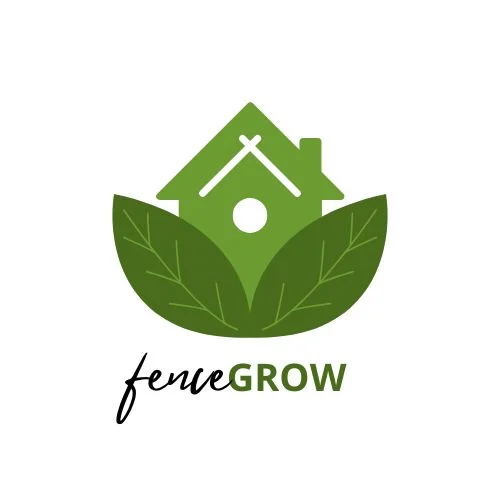
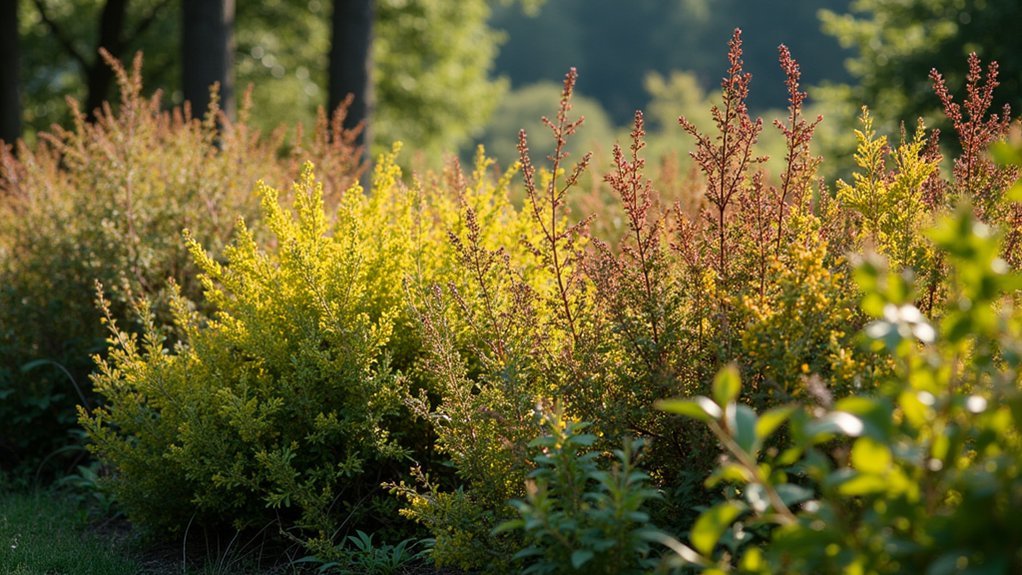

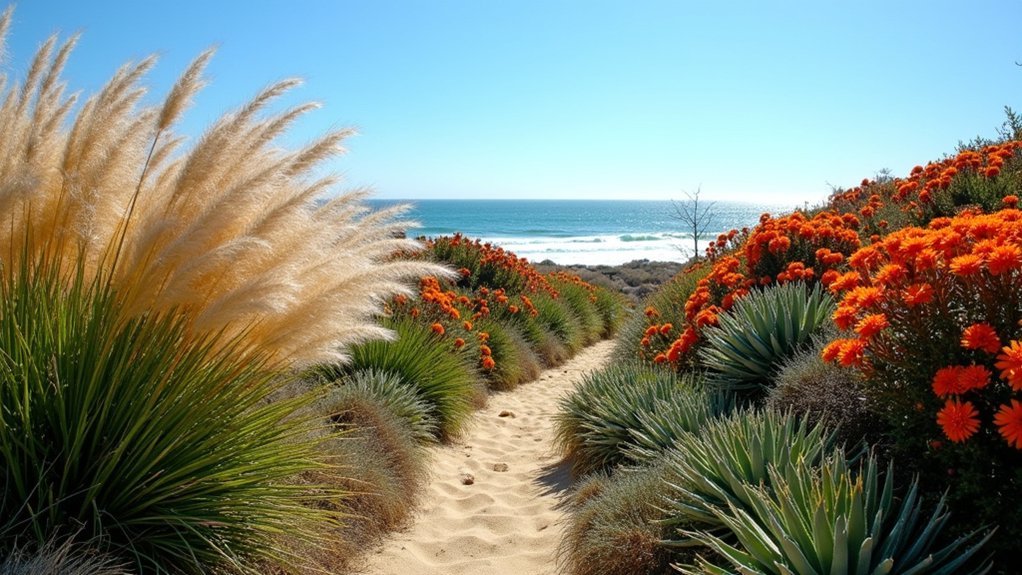
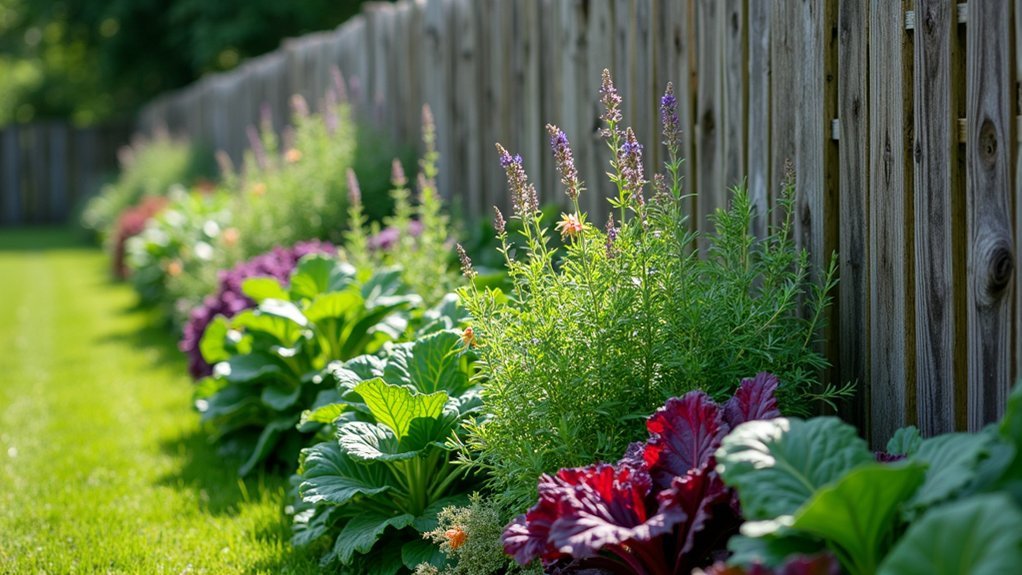
Leave a Reply